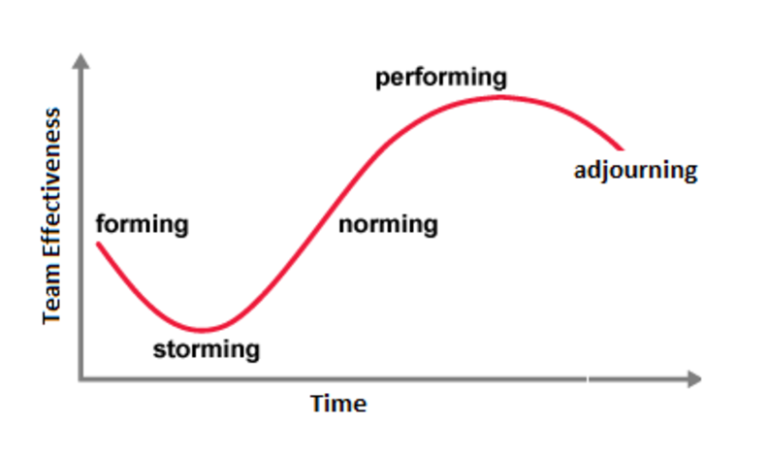STEPS TO GROUP DISCUSSION MAKING
Broadly there exist two scenarios regarding group discussion. Either you have to conduct it or participate in it. In both the scenarios, a proper understanding of the process of group discussion is must. The person responsible for conducting a group discussion is known as moderator. Whether conducted in a formal or informal environment it is always advisable to follow a proper procedure to make group discussion an effective exercise.
Bruce Tuckman's model of group development or Group discussion making includes the stages of Forming, Storming, Norming, Performing, and Adjourning, and provides a comprehensive framework for understanding and enhancing group decision-making processes.
1. Forming: Setting the Stage
In the initial stage of group decision-making, known as Forming, it is essential to set a solid foundation for the discussion. This begins with orientation, where group members are introduced to one another, establishing a sense of familiarity and trust. During this phase, the purpose of the discussion is clearly articulated, ensuring that all members understand the overarching goal and the importance of their contributions. Following the orientation, goal setting takes place. Here, the specific objectives and desired outcomes of the discussion are defined in clear, measurable terms. This step is crucial as it provides a roadmap for the discussion, guiding the group towards a common target. Lastly, An agenda is distributed to all participants, outlining the key topics to be covered. This helps in keeping the discussion focused and ensures that all relevant issues are addressed in a systematic manner.
2. Storming: Encouraging Open Dialogue
During the Storming phase of group decision-making, fostering open communication is paramount to harnessing the collective intelligence of the team. This stage encourages all members to express their ideas and opinions freely, creating a diverse pool of perspectives from which to draw insights. To manage potential conflicts that arise from differing viewpoints, constructive conflict management techniques are employed. This ensures that disagreements are addressed respectfully and resolved in a manner that considers all perspectives, thereby preventing discord from derailing the discussion. Additionally, roles are assigned strategically such as facilitator, timekeeper.
3. Norming: Building Consensus
In the Norming phase of group decision-making, the focus shifts towards building consensus and solidifying the foundation for collaborative action. Central to this stage is the clarification of ideas, where points discussed are summarized and clarified to ensure mutual understanding among all participants. Here, norms are established to guide the discussion effectively. Ground rules are agreed upon, such as respecting speaking turns, staying on topic, and actively listening to others' viewpoints. These norms promote a respectful and inclusive environment where each member feels valued and heard. Furthermore, encouraging collaboration is key to harnessing the collective intelligence of the group. By fostering an atmosphere where members feel comfortable building on each other's ideas and perspectives, the group leverages diverse insights and experiences to reach consensus and make informed decisions collaboratively.
4. Performing: Making Decisions
During the Performing phase of group decision-making, the focus shifts towards making informed and decisive choices based on the discussions and insights gathered. This phase employs structured decision-making techniques such as brainstorming, nominal group technique, or multi-voting to generate and evaluate options systematically. The goal is to reach consensus among group members, where everyone agrees on the best course of action. However, in cases where consensus proves challenging, the group remains flexible and prepared to use majority voting to make a final decision. By leveraging structured decision-making and thorough evaluation in the Performing phase, groups can effectively translate discussions into actionable decisions that align with their objectives and contribute to their success.
5. Adjourning: Implementing and Reflecting
In the final phase of group decision-making, known as Adjourning, the focus shifts towards implementing the decisions reached and reflecting on the discussion process. A crucial step in this phase is to develop a clear action plan that outlines specific tasks, responsibilities, and deadlines based on the decisions made during the discussion. Additionally, documenting the outcomes of the discussion is essential. Detailed minutes are compiled, summarizing key points discussed, decisions made, and action items identified. These minutes are then distributed to all members to ensure transparency and accountability. Furthermore, scheduling follow-up meetings is vital to monitor progress, address any challenges that arise, and make necessary adjustments to the action plan as needed. By effectively implementing decisions, documenting outcomes, and conducting thoughtful reflections in the Adjourning phase, groups can ensure continuity, accountability, and ongoing success in achieving their goals.
One of the more obvious applications of Group Discussion concepts is in the area of group decision-making. We communicate information to make decisions. Moreover, group decisions require transmitting messages between members, and the effectiveness of this communication process will significantly impact the quality of group decisions. Rohini Aggarawal have listed out steps of Group Decision making in her book named ‘Business Communication and Organization and management,’ important to note here that no decision- making team follows exactly the same process for solving problems as another team. However, most high-quality decisions are reached by performing these basic functions…
Step 1: Identify the problem
Step 2: Define the problem
Step 3: Develop alternatives
Step 4: Analyzing alternatives
Step 5: Selecting an alternative
Step 6: Implement the decision

Post a Comment